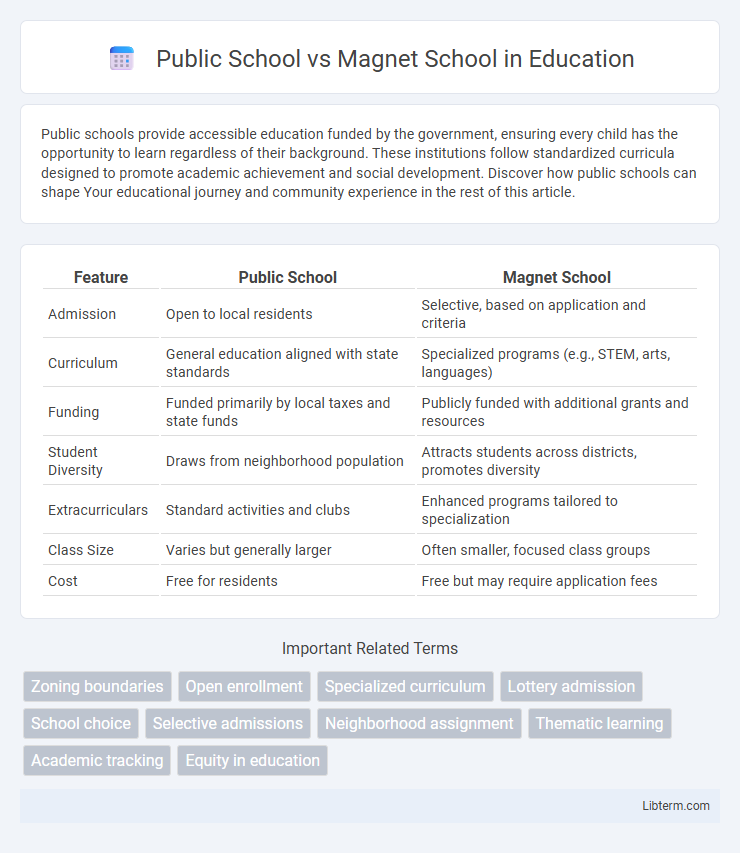Public schools provide accessible education funded by the government, ensuring every child has the opportunity to learn regardless of their background. These institutions follow standardized curricula designed to promote academic achievement and social development. Discover how public schools can shape Your educational journey and community experience in the rest of this article.
Table of Comparison
| Feature | Public School | Magnet School |
|---|---|---|
| Admission | Open to local residents | Selective, based on application and criteria |
| Curriculum | General education aligned with state standards | Specialized programs (e.g., STEM, arts, languages) |
| Funding | Funded primarily by local taxes and state funds | Publicly funded with additional grants and resources |
| Student Diversity | Draws from neighborhood population | Attracts students across districts, promotes diversity |
| Extracurriculars | Standard activities and clubs | Enhanced programs tailored to specialization |
| Class Size | Varies but generally larger | Often smaller, focused class groups |
| Cost | Free for residents | Free but may require application fees |
Introduction to Public and Magnet Schools
Public schools are government-funded institutions that offer free education to all students within a designated geographic area, emphasizing a broad curriculum designed to meet state education standards. Magnet schools, which are also publicly funded, provide specialized programs in areas such as science, technology, arts, or languages to attract a diverse student body from across traditional school boundaries. Both types of schools aim to deliver quality education but differ in their enrollment processes, curricular focus, and instructional approaches.
Key Differences Between Public and Magnet Schools
Public schools are funded and operated by government agencies, serving all students within a designated geographic area, while magnet schools are public schools with specialized curricula designed to attract a diverse student body from various districts. Magnet schools emphasize advanced programs in areas like STEM, arts, or languages, providing tailored educational experiences that go beyond traditional public school offerings. Enrollment in magnet schools often involves an application process focused on academic aptitude or interest, contrasting with the automatic enrollment found in public schools.
Admissions Process: Public vs Magnet Schools
Public school admissions typically follow a neighborhood-based enrollment system, prioritizing students residing within designated districts to ensure equal access. Magnet schools implement a selective admissions process that often includes applications, academic records, and sometimes entrance exams or auditions to attract students with specialized interests or talents. The competitive nature of magnet school admissions aims to create diverse, high-achieving student bodies aligned with specific educational themes or programs.
Curriculum and Academic Focus
Public schools offer a broad curriculum designed to meet state education standards, covering core subjects and elective courses to accommodate diverse student interests. Magnet schools emphasize specialized academic programs such as science, technology, engineering, arts, and mathematics (STEAM), fostering in-depth knowledge and advanced skills through targeted instruction. The focused curriculum in magnet schools attracts students seeking rigorous academics and thematic learning environments aligned with their talents and career goals.
Diversity and Student Demographics
Magnet schools typically attract a more diverse student body by offering specialized programs that draw students from various geographic areas, enhancing multicultural interaction and inclusion. Public schools primarily serve local neighborhoods, which often results in less demographic variety and a student population that mirrors the surrounding community's racial and socioeconomic makeup. Research shows that magnet schools tend to have higher percentages of minority students and greater socioeconomic diversity compared to traditional public schools.
Extracurricular Activities and Enrichment Programs
Public schools offer a broad range of extracurricular activities and enrichment programs designed to cater to diverse student interests, including sports, music, clubs, and academic competitions. Magnet schools provide specialized programs that emphasize advanced academics and arts, often featuring unique opportunities such as STEM labs, performing arts workshops, and targeted mentorship. Both school types aim to enhance student engagement and development but differ in program focus and resource allocation.
Teacher Qualifications and Staff Support
Magnet schools typically employ teachers with specialized certifications and advanced training aligned with focused curricula in areas like science, technology, or the arts, enhancing instructional quality. Public schools often have a broader range of teacher qualifications reflecting diverse subject requirements, with state-mandated credentials ensuring baseline competency. Staff support in magnet schools includes specialized professional development and resources tailored to thematic programs, while public schools provide varied support systems to address the needs of larger, more heterogeneous student populations.
Cost, Funding, and Resources
Public schools are primarily funded through local property taxes and state allocations, resulting in varying resources based on community wealth and often lower overall costs for students. Magnet schools receive additional federal and state grants aimed at specialized curricula, which can enhance resources but may require competitive admissions, influencing accessibility. Both types of schools provide free education, yet magnet schools often offer advanced facilities and programs due to targeted funding streams.
Academic Performance and Outcomes
Magnet schools consistently demonstrate higher academic performance compared to traditional public schools, often reflected in standardized test scores and graduation rates. These schools focus on specialized curricula in areas like STEM or the arts, attracting motivated students and fostering advanced learning environments. Research indicates that students attending magnet schools are more likely to pursue higher education and achieve improved long-term academic outcomes.
Choosing the Right Fit: Factors for Parents and Students
Choosing the right fit between public schools and magnet schools depends on factors such as curriculum focus, extracurricular offerings, and available resources aligned with the student's interests and academic goals. Public schools often provide a broad, community-centered education with diverse student populations, while magnet schools offer specialized programs in areas like STEM, arts, or language immersion that cater to specific talents and career aspirations. Parents and students should evaluate school performance reports, faculty expertise, and the overall learning environment to ensure the best match for academic success and personal development.
Public School Infographic

 libterm.com
libterm.com